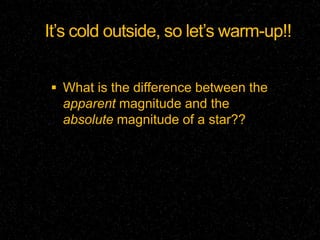
Notes nebula starlife
- 1. It’s cold outside, so let’s warm-up!! What is the difference between the apparent magnitude and the absolute magnitude of a star??
- 2. How stars SHINE!!!!! get ready to take notes!
- 3. The Life of a Star… 1. Protostar- born in a 3. Red giant/supergiant- nebula, gases come when stars run out of together and begin fuel, the outside nuclear fusion. expands and the inside 2. Star- the phase where contracts. the star burns fuel. The 4. White Dwarf-One more massive the star, possible outcome. The the shorter it’s lifespan! remainder of a star, after the outer layer expands away.
- 4. The Life of a Star… 5. Super Nova- If a star 7. Black Hole- The most doesn’t become a white massive pre-supernova dwarf, it will supernova stars may become (aka- explode!) black holes after they 6. Neutron Star- What’s supernova. The density left after a supernova reaches extreme highs (suuuuper dense core) and pulls everything inward to the point where light cannot even escape!
- 5. How do stars produce light?? Stars emit TONS of energy!! We can see some of it in the form of visible light. When the temperature of a protostar (star beginning to form) gets hot enough Nuclear FUSION occurs.
- 6. How do stars produce light?? Stars produce light by Nuclear FUSION. This is when two atomic nuclei combine to form a larger nucleus with a higher mass. (ex: hydrogen becomes helium)
- 7. How stars FORM Nebula- A large cloud in space The space between containing dust, stars is called hydrogen gas, helium interstellar space and gas and plasma. it contains mostly gas and dust. It’s density is extremely low- *Stars are formed in approximately 1 atom nebulae per cubic meter.
- 8. Components of Nebulae The dust in a Nebula is not like house dust, it’s made up of much smaller particles that typically includes carbon and silicate molecules
- 9. These beautiful regions of nebula, the formation of gas, dust and other materials clump together to form larger masses which attract more matter and eventually get big enough to form a star. Here are some examples…
- 10. This picture was taken from the Hubble Telescope, it’s called “NGC- 604” and is located in a neighbor spiral galaxy of ours, 2.7 million light years away from us.
- 11. These are the star forming “Pillars of Creation” spotted by the Hubble Telescope.
- 12. Many Nebula form from the gravitational collapse of gas in the interstellar medium (ISM). As the material collapses under it’s own weight, stars may form in the center. Here are some examples…
- 13. This is the Rosetta Nebula in the Monoceros region of our galaxy- the Milky way! It is 5,200 light years from Earth. It is roughly 130 ly in diameter. It’s mass = 10,000 solar masses! Wow!
- 14. This is the Flame Nebula located in the constellation of Orion. The heart of the nebula is usually hidden by the dust but this image was taken in IR light and it’s beauty was exposed!
- 15. Some nebula are the result of supernova explosions (the death of short lived massive stars.) Example…
- 16. This is the Crab Nebula in the Constellation of Taurus. This Nebula is actually visible with the naked eye on a clear night.
- 17. Some Nebula are called “Dark Nebula” and seem to be the creepers of the bunch (if you ask me), they tend to look a little more scary. Such as…..
- 18. This is a dark nebula called “Horse Head” It’s so dense that it obscures light from behind it.
- 19. And our last beauty for the day: Planetary Nebula- These are the gaseous shells that are ejected as giant stars transform into white dwarfs. Example…
- 20. This is called the Helix Nebula (Planetary Nebula)
- 21. This is the Eskimo Nebula (planetary Nebula)
- 22. Cat Eye Nebula